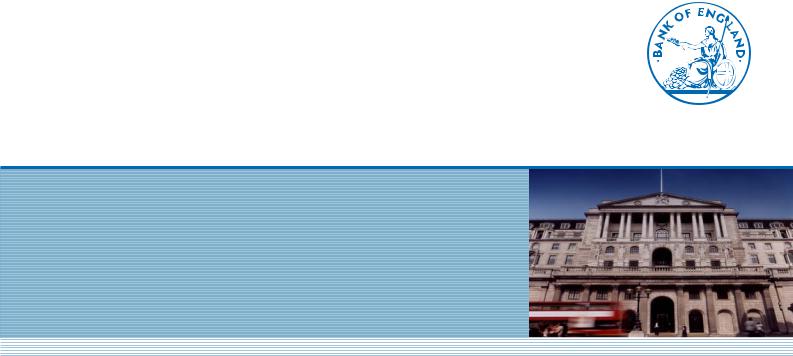
СТАТИСТИКА 1 / Банк Англии / 2006full
.pdf
Bank of England
Annual Report 2006


Bank of England
Annual Report 2006
Contents
3The Bank’s Core Purposes
4Foreword by the Chairman of NedCo
6Foreword by the Governor
8Governance and Accountability
10 The Court of Directors
12 The Executive Team
14 Organisation Overview
16 Review of 2005/06
25 The Bank’s Priorities in 2006/07
27 Financial Review
30 Remuneration of Governors, Directors and MPC Members
34 Governance, Financial Statements and Risk
42 Report by the Non-executive Directors
48 Report of the Independent Auditors
The Bank’s Financial Statements
50Banking Department Income Statement
51Banking Department Balance Sheet
52Banking Department Statement of Recognised Income and Expense
53Banking Department Cash Flow Statement
54Notes to the Banking Department Financial Statements
110Issue Department Statements of Account
111Notes to the Issue Department Statements of Account
Addresses and Telephone Numbers
1

2

Bank of England Annual Report 2006
The Bank’s Core Purposes
The Bank’s Core Purposes are determined by Court as part of its role in setting the Bank’s
Objectives and Strategy. The statement below was reaffirmed by Court in May 2006.
The Bank of England exists to ensure both monetary and financial stability.
Core Purpose 1 — Monetary Stability
Monetary stability means stable prices and confidence in the currency. Stable prices are defined by the Government’s inflation target, which the Bank seeks to meet through the decisions on interest rates taken by the Monetary Policy Committee, explaining those decisions transparently and implementing them effectively in the money markets.
Core Purpose 2 — Financial Stability
Financial stability entails detecting and reducing threats to the financial system as a whole. Such threats are detected through the Bank’s surveillance and market intelligence functions. They are reduced by strengthening infrastructure, and by financial and other operations, at home and abroad, including, in exceptional circumstances, by acting as the lender of last resort.
In pursuit of both purposes the Bank is open in communicating its views and analysis and works closely with others, including:
●Other central banks and international organisations to improve the international monetary system.
●HM Treasury and the Financial Services Authority, under the terms of the Memorandum of Understanding, to pursue financial stability.
The Bank will also play its part in promoting an open and internationally competitive financial centre in the United Kingdom, using its expertise to help make the UK financial system more efficient, where such efforts would be in the public interest and provided that they do not conflict with its primary responsibilities or those of other agencies.
3

Bank of England Annual Report 2006
Foreword by the Chairman of NedCo(1)
Sir John Parker, Chairman
In my first full year as the Chairman of the Committee of Non-executive Directors (NedCo) I have been struck how the Bank combines its respect for its traditional values with a progressive attitude towards managing. This has led to continuous improvements in the delivery of its core purposes.
We can look back on a year of significant progress. Our strategic debates have been crystallised by the Executive into a well defined set of priorities for 2006/07 linked to a reformed budgetary framework. These priorities will provide continuing momentum for the current programme of change.
During the year the Bank controlled its costs effectively, and it has delivered an outturn within the budget targets set by Court.
In addition it has been a year in which important milestones have been achieved. The preparation for the new framework for the Bank’s money market operations, launched in May this year, is particularly noteworthy. We also undertook a major restructuring of the Financial Stability (FS) area coupled with a clarification of its primary purposes. This refocusing of FS together with the welcome tripartite review by Treasury, FSA and the Bank of the Memorandum of Understanding has given greater clarity to our respective roles, including those in the event of a financial crisis.
Progress however has gone beyond meeting these important milestones in that there has been further meaningful progress in the development of the Bank’s management systems. We now have a more relevant cost accounting framework, allowing greater individual Executive accountability and more effective cost control across all of the Bank’s activities. We have also made considerable progress in embedding leading project management practices which embrace all significant projects.
I am pleased with these outcomes and the fact that once again the Executive have responded very positively to the debates within NedCo on important control and accountability issues.
Commitment to continuous improvement and to being at the leading edge of central banks’ practices mean that there is inevitably more to do. In particular, we will be looking to make further progress with the Bank’s HR strategy in 2006/07 and take further steps in developing a more structured performance measurement and reward-linked system. Additionally, we will need to review the extent to which the refocus of the Bank’s financial stability work meets its objectives.
It has been gratifying for the Bank to have reached a very successful conclusion to the BCCI trial. Non-executive Directors have strongly supported the Governor’s stance in relation to the allegations made against the Bank and its
(1) The Committee of Non-executive Directors.
4

Bank of England Annual Report 2006
employees. I would wish to record my appreciation of the Governor’s steadfast commitment to defending the reputation of the Bank and its staff in the face of this litigation. NedCo will continue to lend its full support as the Bank now seeks to recover its costs.
We continue, via formal and informal process, to evaluate the effectiveness of NedCo and Court on an annual basis. This is to ensure that we are not only effective in facilitating and challenging the Executive Team’s management of the Bank but that we are fully meeting our responsibilities, as non-executive Directors, under the Bank of England Act.
Following on from the 2004/05 formal Board evaluation we have worked throughout the year on the action plan which flowed from it. This has largely been successfully executed. It has brought about important changes to improve the effectiveness of NedCo. These have included improving contact with the Treasury and greater opportunity to meet the Heads of Department in the Bank. It also led to non-executive Directors having greater individual contact with myself as Chairman, as well as sharing more informal time together to discuss issues.
Importantly, I believe NedCo through its process has contributed and challenged at the appropriate level and yet not invaded the space that is rightly that of the Governor and the Executive management. That is an ongoing challenge for any board and, once again, I will keep the operation of NedCo under continuous review as part of my role and ensure NedCo takes all necessary actions to improve its effectiveness.
Our Committees of Audit, Risk Policy and Remuneration have all continued to do important work. They have each been very effective with regular reports to NedCo. I am grateful to the Chair of each of these Committees for their professional leadership.
NedCo continues annually to ensure that the Bank provides members of the MPC with satisfactory flow of quality information and research to enable them to discharge their important duties effectively. This is carried out by an annual survey along with individual interviews with each MPC member (excluding the Governor) by myself. I am glad to report that MPC members collectively and individually had high praise for the Bank’s support and the leadership of the Governor, as Chair of the MPC.
My thanks and appreciation go to Sir Brian Moffat and Sir William Morris (Chairman of our Remuneration Committee) for their service as Directors of the Bank. I
warmly welcome David Rhind, James Strachan and Bob Wigley who join us in June. We have a rich array of talent and experience in our Members of Court, and I am grateful for the dedication and professionalism they have brought to bear on our debates during this past year.
May 2006
5

Bank of England Annual Report 2006
Foreword by the Governor
|
|
|
|
|
|
|
|
|
|
|
|
|
|
|
|
Mervyn King, Governor |
In our Annual Report two years ago I described the Bank’s |
|
strategic review, which started just after I became Governor, |
|
and the restatement of our Core Purposes that flowed from it. |
|
The vision was and remains to focus the Bank on the core |
|
functions set out in the 1998 Bank of England Act. We have |
|
reviewed each of the Bank’s individual businesses, and set |
|
priorities which form the basis of our spending plans over the |
|
next three years. |
|
The current priorities are described on page 16, but already |
|
we can claim to have made significant progress. The MPC has |
|
remained successful in meeting its objective: inflation is |
|
currently close to target and output close to trend. To meet |
|
the challenges ahead we need to keep our analysis at the |
|
cutting edge and to this end we are working towards a leaner |
|
and more experienced team of economists. In the |
|
implementation of monetary policy we have reformed our |
|
money market operations: these now represent a new |
|
benchmark for international best practice. Financial Stability |
|
has been reorganised, to focus on the assessment and |
|
reduction of risk under the oversight of the Financial Stability |
|
Board; and through a revision to the 1997 Memorandum of |
|
Understanding, we have clarified the Bank’s role in Financial |
|
Stability in relation to those of the Treasury and the FSA. |
|
All this is reflected in our strategy for the coming year |
|
(page 25) and we have made particular efforts to engage the |
6

Bank of England Annual Report 2006
Bank’s staff, both in the planning process and in the launch of our annual priorities statement. In every part of the Bank we are dependent on the skills, experience and commitment of our staff.
Towards the end of the year the action brought against the Bank by the Liquidators of BCCI, which began in 1993 and went to trial in January 2004, was unconditionally withdrawn. In the action 22 current and former members of the Bank’s staff were accused of dishonesty in their supervision of BCCI. There had never been a shred of evidence to support these disgraceful allegations. The Judge himself said on the day the case was dropped that the allegations against all 22 Bank Staff were ‘wholly without foundation’, and in his judgement, delivered in April 2006, he went on to disclose that a year previously that he had become so concerned about the case that he had decided both to consult and to warn the
Lord Chief Justice that the case was ‘a farce’, and that ‘the case as it was being pursued before me bore little or no relation to that which the House of Lords had considered fit to proceed to trial’. The Liquidators have been ordered to pay the Bank’s costs on an indemnity basis. I am delighted that this foolish litigation has been brought to an end.
I am grateful to the Bank’s Court for their continuing support and guidance as we deliver the strategy. Bill Morris and Brian Moffat both leave Court having made substantial
contributions over the past six years: and I welcome
David Rhind, James Strachan and Bob Wigley. Andrew Large left the Executive at the end of 2005 having made a notable contribution both to risk management within the Bank and to our business continuity arrangements, and in his place I welcome John Gieve as Deputy Governor for Financial Stability. I am also very pleased to welcome Juliet Wheldon, the Treasury Solicitor and Head of the Government Legal Service, who joins as Chief Legal Adviser in August.
I would like to thank the Deputy Governors and Executive Team for their full support in translating the vision into a reality. Finally, I would like to extend my thanks to the staff at the Bank, without whose skills, flexibility and commitment we would not have achieved so much over the past three years.
Governor of the Bank of England
May 2006
7

Bank of England Annual Report 2006
Governance and Accountability
The current governance and accountability framework is set by the 1998 Bank of England Act, which provides for a Court of Directors, a Committee of Non-executive Directors within Court, and a Monetary Policy Committee.
THE COURT OF DIRECTORS
Court consists of the Governor, two Deputy Governors and 16 Directors. The Directors are all non-executive. The Governors are appointed by the Crown for five years and the Directors for three years. Details of the current Court are set out on pages 10–11. There remains at the end of the year one vacancy.
Under the Act, the responsibilities of Court are to manage the Bank’s affairs, other than the formulation of monetary policy, which is the responsibility of the Monetary Policy Committee. This includes determining the Bank’s objectives and strategy, and aiming to ensure the effective discharge of the Bank’s functions and the most efficient use of the Bank’s resources.
NEDCO
The Act provides for a Committee of Court (‘NedCo’) consisting of all the non-executive Directors, with a chairman designated by the Chancellor of the Exchequer. The chairman of NedCo is also Deputy Chairman of Court. NedCo has responsibilities for reviewing the Bank’s performance in relation to its objectives and strategy, and monitoring the extent to which the Bank’s financial management objectives are met. NedCo is also responsible for reviewing the procedures of the MPC, and in particular whether the Committee has collected the regional, sectoral and other information necessary for formulating monetary policy. Other functions of NedCo — in which it is supported by the Audit, Risk and Remuneration Committees — include reviewing the Bank’s internal controls and determining the Governor’s and Deputy Governors’ remuneration and the terms and conditions of service of the four members of the MPC appointed by the Chancellor. NedCo is required to make a report as part of the Bank’s Annual Report. This is on
pages 42–47.
Since 2004 the normal practice has been for the business of Court to be discussed in meetings of NedCo, with the Executive present. Formal decisions are then taken in Court. NedCo also holds meetings from time to time without the Executive, so that it can fulfil its reviewing role.
THE MONETARY POLICY COMMITTEE (MPC)
The Bank of England Act establishes the MPC as a Committee of the Bank, subject to the oversight of NedCo, and sets a framework for its operations. Under the Act, the Bank’s objectives in relation to monetary policy are to maintain price stability and, subject to that, to support the Government’s economic policies, including its objectives for growth and employment. At least once a year, the Government specifies the price stability target and its growth and employment objectives. The MPC must meet at least monthly; its members comprise the Governor and Deputy Governors, two of the Bank’s Executive Directors and four members appointed by the Chancellor. Membership of the MPC is given on
page 17. The MPC’s decisions are announced after each monthly meeting and minutes of their meetings are published two weeks later. The quarterly Inflation Report includes the MPC’s projections of inflation and output.
REMUNERATION COMMITTEE
The members of the Remuneration Committee during 2005/06 were Sir William Morris (Chairman),
Sir Graham Hall, Dr David Potter, Peter Jay, Geoffrey Wilkinson and Arun Sarin (from June 2005). The Chairman of NedCo attends meetings of the Remuneration Committee. The Committee’s Report on Remuneration is on pages 30–33.
AUDIT COMMITTEE
The members of Audit Committee during 2005/06 were Amelia Fawcett (Chairman), Sir Brian Moffat, Mary Francis,
8
